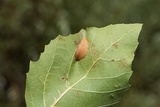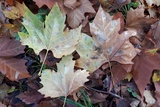Phyllonorycter platani (Staudinger, 1870) Species
Last modified: Nov. 26, 2024, 2:02 p.m.
A very common species throughout Belgium, recorded from all provinces. The leaf mines are sometimes observed in huge quantities.
Details
- Classification
- Family: Gracillariidae > Subfamily: Lithocolletinae > Genus: Phyllonorycter > Species: Phyllonorycter platani
- Vernacular names
- Plataanvouwmot (NL), London midget (EN), Platanenminiermotte (DE)
- First mention in Belgium
- Janmoulle E. 1954a. Espèces nouvelles pour la faune belge (suite). — Lambillionea 54: 3–4, 33–34, 57–58. On page 34.
- Status
-
Native
Distribution
Imago
Head ochreous; forewing ground colour olive brown, a white pattern consisting of a rather long, slightly upwards curved, basal line, finely edged with brown scales; four costal and four dorsal striae, the first pair prolonged along the costa and margin till the base of the wing, the last three pairs touching in the centre, sometimes merging into a transversal band, especially the third pair; a small black dot in the apical area.
Museum specimens
No pictures yet!Specimens in nature
No pictures yet!Mine
At first a long serpentine mine along the veins, later on large tentiform mine on the underside of a leaf. The fully developed mine is greyish green till brownish and shows some longitudinal folds. The caterpillar consumes the parenchyma in an irregular pattern and the upperside of the mine then has an aspect of white-green marmor. The blackish frass is concentrated in one corner of the mine.
See also gracillariidae.net and bladmineerders.be.
Cocoon/pupa
A whitish, round cocoon, away from the heap of frass.
Bionomics
De eggs are deposited on the underside of a leaf, preferably near the basis of a secondary vein. Most of the time, there are several mines on the same leaf, not rarely more than ten. Mines of the summer and autumn generation are much larger than those of the spring generation. Very rarely, also upperside mines occur.
Pupation inside the mine. The species hibernates in the pupal stage. After the emergence of the adult, the pupal skin protrudes from the mine.
Adults rest during day time on tree trunks or among the foliage; they become mainly active at dusk and come to light.
Flight periods
The adults fly in three generations a year from April to October.
Observed on
- Host plant (species):
- Platanus occidentalis and Platanus orientalis
- Host plant (genera):
- Platanus
The species is only recorded from Platanus trees.
Habitat
Road sides, parks and public gardens.


